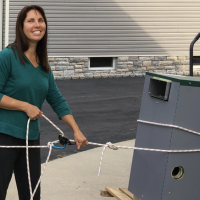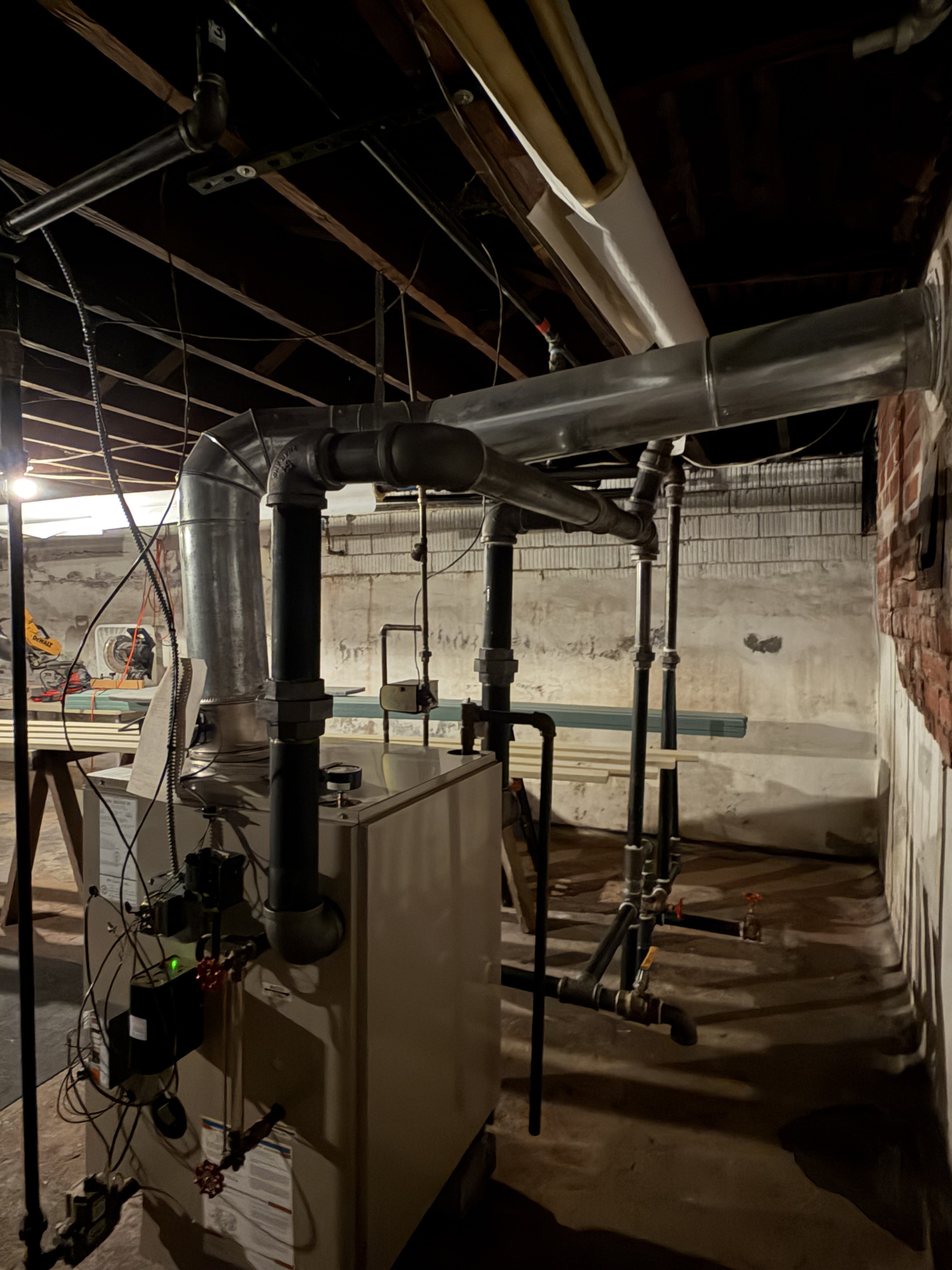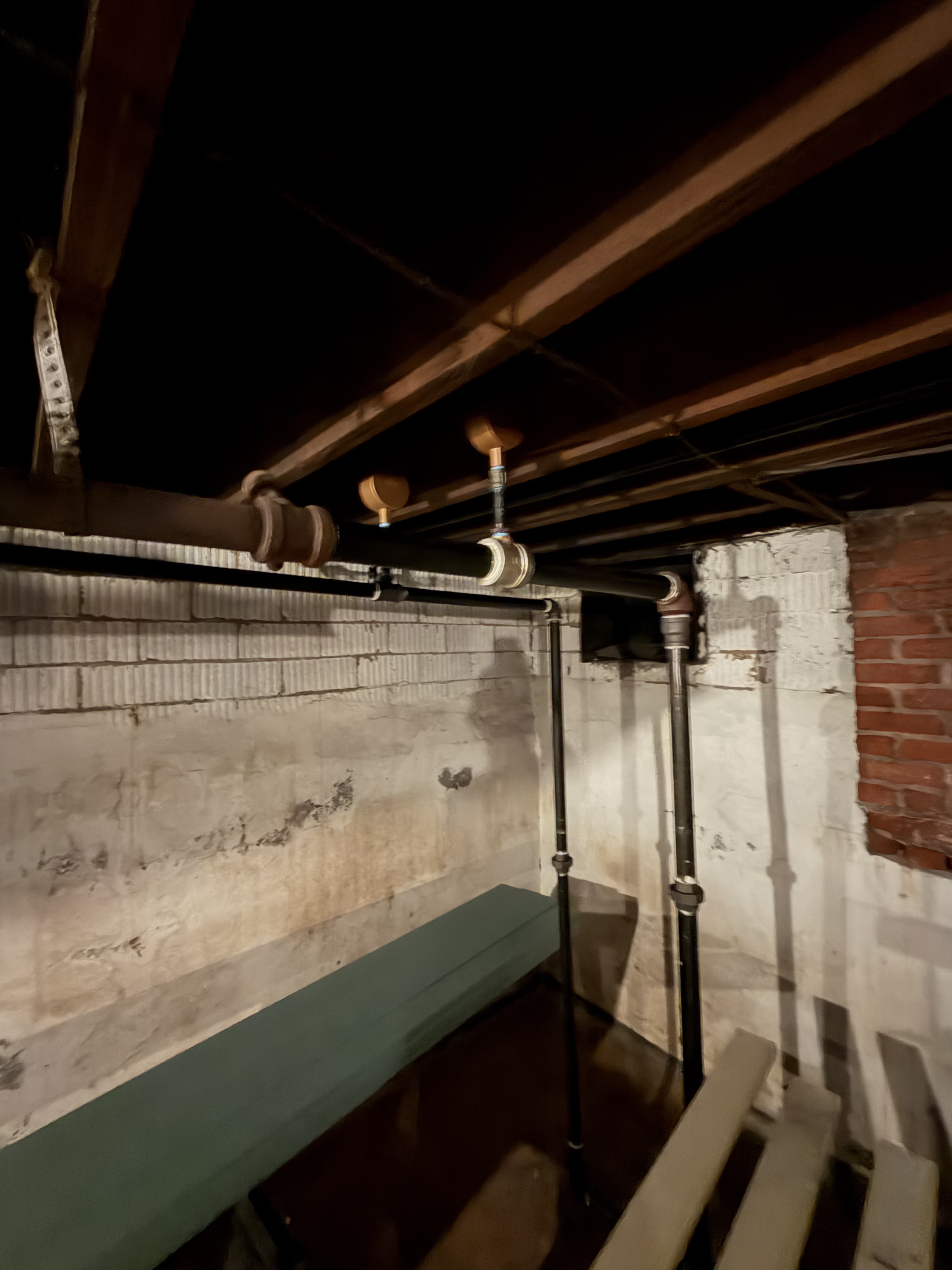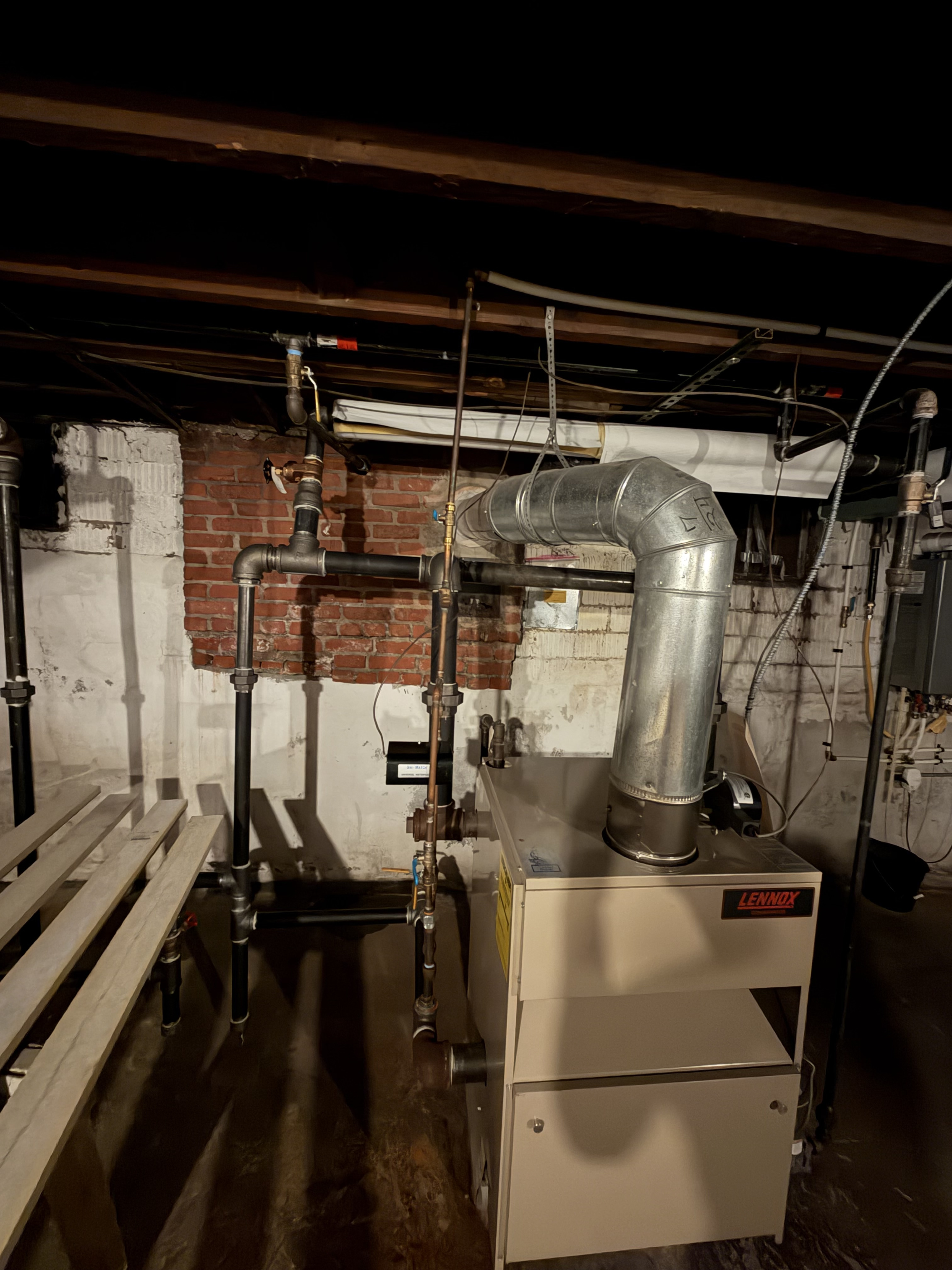Connecting Two Pipe Steam back to the boiler
I have a two pipe steam system that has questionable near boiler piping. It doesn’t match the specs of the boiler manual and i’m getting a lot of water into the mains and then it’s pouring out of the air vent at the end of the returns near the boiler. I see how to re pipe the risers, header, equalizer and connect it to the main but i’m stuck on how the steam main and the dry return combine and return to the boiler. It doesn’t have a f&t trap. The steam main and the dry return run parallel throughout the building and back to the boiler. I’m confused about if the two returns can combine right at the boiler, similar to how it is now or if it’s supposed to combine further away with a f&t trap and only have one pipe connecting back to the boiler. And i don’t know what kind of main vents/traps i’m supposed to have and where to put them. Any help is appreciated.
Comments
-
I think you may have some comfusion regarding returns.
The high level returns — usually running close to the steam mains, are dry returns. They do carry condensate, but there isn't much of that, and air from the radiators. They must NOT be flooded, and the join together at the boiler and then drop to the floor level or near it.
The low level returns — usually at or near floor level — are below the boiler water line, and are always flooded. They are called wet returns for that reason. They carry condensate from any steam piping or dry returns which are pitched away from the boiler.
In your pictures I do not see any wet returns at all — so everything else is pitched back to the boiler (or should be!). If you are getting water building up at the ends of the steam mains or dry returns, they are pitched the wrong way.
Unless, that is, some bright individual in tidying up the basement removed the wet returns which should have been there to take drips from the steam mains and dry returns…
Now there is another problem: the near boiler piping is rather badly wrong. No header, only one riser, no real equalizer.
Br. Jamie, osb
Building superintendent/caretaker, 7200 sq. ft. historic house museum with dependencies in New England1 -
Has this boiler ever been skimmed?. It looks to me that the near boiler piping although far from textbook should work. My only question is if one or two risers are required for that size boiler. Check The boiler manual
How is the boiler water level when it is steaming? Violent fluctuations of the water level? Or steady water level meaning gentle movements not exceeding 1" up and down
2 -
That near-boiler piping will never work right. For starters, there is no header. Then, the riser from the boiler looks like 2-inch, and there is only one riser where there should be two. The result is water is getting up in the steam mains, causing the problems you cite.
This boiler has the name Lennox, but is a re-branded Dunkirk. Dunkirks are extremely sensitive to improper piping.
It needs to be properly repiped. Period.
All Steamed Up, Inc.
Towson, MD, USA
Steam, Vapor & Hot-Water Heating Specialists
Oil & Gas Burner Service
Consulting4 -
The company that installed it in the early 2000s piped it this way. I’ve been trying to figure out how to fix it. I need to get it right so i can insulate the pipes and hopefully lower my bills. The manual is in my original photos. It can be piped with one or two risers I was going to do two assuming two is better than one but one would be easier if it won’t cause a problem. I don’t understand how the main and dry return lines are supposed to connect back to the boiler and where the vents/traps are supposed to go. I don’t want to start until i have it planned out. When the boiler fires it, hammers mid cycle, gets low water, adds water, then pours water in the floor out of the hoffman no.75 vent pictured. That is why there is rust stains on the floor.The dole no.5 vent never seems to do anything. And yes it’s been skimmed several times. And I replaced every valve and steam trap when i moved in and that helped but now i’m trying to get this piping right. I would clean it more but it doesn’t have the gate valve on the main to blow it out.
0 -
OK. That first picture from the manual posted here shows the minimum near boiler piping needed. The thing which is a little confusing is that you have the outer end of the steam main right at the boiler, which is a bit odd but not a problem.
The silver vent is the main vent for the steam mains. What should happen is that eventually it should get hot and close. If steam takes a long time to get there, it may be failed shut In any event, I'd replace it with a Gorton #2.
The brass Hoffman vent is the vent for the dry returns from the radiator steam traps which are coming in there. It's probably fine.
Both of those pipes then go into vertical pipes, called drips. They meet together below the water line, which is fine, It looks to me as though there is another return dry return in addition to the one you have marked. That should be tied together with the one you did mark more or less where the Hoffman vent is.
The line which drops down vertically from that to the loop of pipe attached to the boiler is going to go away.
Then you need to build that bit of piping called the Hartford Loop in the diagram, just as it is shown. It looks as though someone tried to make a Hartford Loop — but the return pipe needs to go into the leg of the loop which does not attach directly to the boiler, rather than to the one which does.
Now you need to pay attention to the header piping. Arrange it exactly as the diagram shows. Two risers going up — one from each side of the boiler — at least two feet. Then going over horizontal another foot or so, and both connecting to the horizontal pipe as shown. That header should have a very slight slope down to the right. Then connect your steam main in beyond where the two risers join the header. Then go a bit farther and take a vertical pipe, called the equalizer, down to that Hartford Loop.
It really isn't hard if you follow that diagram as exactly as you can. Pay attention to the pipe sizes and any dimensions shown.
Better yet. Where are you located? We just might know someone nearby who could do all that for you in less than a day…
Br. Jamie, osb
Building superintendent/caretaker, 7200 sq. ft. historic house museum with dependencies in New England1 -
Thank you. All that was helpful. I’m in East Tennessee and haven’t found anyone that actually knows steam.
0 -
It’s just the two return lines. You may be seeing the weird way they did the equalizer or the gas line. Can i swap out the 90 at the bottom of this return line in the diagram for a T and connect my 2 return lines that way? Then put the vents on 6-10 inch stub before it turns down to go into the hardford loop? The vents are close to my floor joists currently and the steam is rotting them. Is it acceptable to step the return lines down maybe a foot lower a little bit away from the boiler, so i have head room to put the vents up on a stub like it suggests? Also, is the reason i don’t need an F&T trap because the steam main circles all the way back to the boiler as a dry return instead of stopping at the last radiator?
0 -
All that should be OK.. You don't need a trap the way yours is laid out. The steam in the steam main is separated from the dry return by the water at the bottom of the vertical pipes.
Br. Jamie, osb
Building superintendent/caretaker, 7200 sq. ft. historic house museum with dependencies in New England1 -
Can anyone tell me if I can put one gorton #2 on each return pipes? I’m assuming both the hoffman no.75 and the dole no.5 are broken and need replaced. The one squirts out water and the other does nothing. I was wondering if i should go ahead and replace them both. I could probably use the extra venting anyway. The main is about 50 foot of 2 inch dia and the return from the steam traps is about 50 foot of .75 dia. I’m confused if the main line return requires more venting than the dry returns coming from my radiators steam traps.
0 -
Yes you can. Keep in mind that the dry returns should connect together before they drop to the wet return BEFORE the Hartford Loop, so they are also venter together. I'm not sure what you mean, though, but your main dry return? Is that a true dry return, or is it a steam main extension? People often refer to those as dry returns, but they aren't — since they are extensions of the steam main without traps intervening, they are still steam mains, and they must be dripped to the wet return BEFORE the Hartford Loop and must NOT connect to a true dry return in any way — and thus they need to be vented separately.
Br. Jamie, osb
Building superintendent/caretaker, 7200 sq. ft. historic house museum with dependencies in New England0 -
I attached a diagram of how mine is done. I don’t know. I thought you said they were called dry returns before so that’s what i was calling them. What’s a steam main extension? The steam main just goes in a U shape around the basement and comes back to the hardford loop and the dry return from my steam traps also make a U and go into the hardford loop. I was under the assumption they shouldn’t mix and should have separate vents about 16 inches from where they drip. I’m just trying to figure it out before i buy all this stuff to fix it. I don’t know if they would need the same vents or maybe one would require more vents. You can see in my first post what they look like now but I’m about to redo it.
0 -
Ok. Having the main loop around the basement is fine. Arrange your boiler piping to the supply end of the main as discussed.
The other end of the main loop gets a vent and needs to drop to tie in to the wet return and Hartford loop.
If the vents are spewing steam and rotting the joists, they've failed and need to be replaced.
The dry return coming from your radiator traps also needs a vent and then to drop down to the wet return and Hartford Loop.
I take it that there is no connection between your steam main and your dry return? Per your diagram.
Trying to squeeze the best out of a Weil-McLain JB-5 running a 1912 1 pipe system.0 -
No, they don’t join anywhere except the wet return.
0 -
That works. The mains need vents then where they drop to the wet return.
Trying to squeeze the best out of a Weil-McLain JB-5 running a 1912 1 pipe system.0 -
-
Kind of hard to see with my boards in the way, but I got the near boiler piping redone and the returns connected how i wanted a few months ago. 2 new air vents too . I haven’t finished installing the insulation yet. It’s working much better but the upstairs radiators are still having trouble getting hot. They only get hot all the way across when the boiler has been firing a long time where the downstairs gets hot pretty quickly. Like if it’s really cold outside or i set the temp up a few degrees and it fires a long time to get there. I have the thermostat set to stay on 20 mins at a time minimum and that helps some but it’s not perfect. Upstairs is usually 5 degrees colder than downstairs. Pressuretrol is as low as it will go. About .5 with the cut out wheel on 1. I’m assuming it’s a balance issue but not sure what I can do. The longest run is probably no more than 60 feet. Everything should be in working order on the radiators. I suppose there could be something weird or stopped up in the wall that i can’t see. Any suggestions to make the upstairs and downstairs radiators in balance? It’s two pipe steam with thermostatic radiator traps. I thought you weren’t supposed to halfway close valves but now i’m second guessing that and wondering if i should close the downstairs radiators some.
0 -
With a 2 pipe system the radiator valves (or orifices) are commonly used to control the steam to their specific radiator.
With a 1 pipe system the radiator valves should be all the way open or closed, the radiator's air vent should control the fill rate of the radiator for balancing.
National - U.S. Gas Boiler 45+ Years Old
Steam 300 SQ. FT. - EDR 347
One Pipe System1
Categories
- All Categories
- 87.2K THE MAIN WALL
- 3.2K A-C, Heat Pumps & Refrigeration
- 60 Biomass
- 427 Carbon Monoxide Awareness
- 119 Chimneys & Flues
- 2.1K Domestic Hot Water
- 5.8K Gas Heating
- 115 Geothermal
- 165 Indoor-Air Quality
- 3.7K Oil Heating
- 75 Pipe Deterioration
- 1K Plumbing
- 6.4K Radiant Heating
- 394 Solar
- 15.6K Strictly Steam
- 3.4K Thermostats and Controls
- 56 Water Quality
- 51 Industry Classes
- 49 Job Opportunities
- 18 Recall Announcements

















